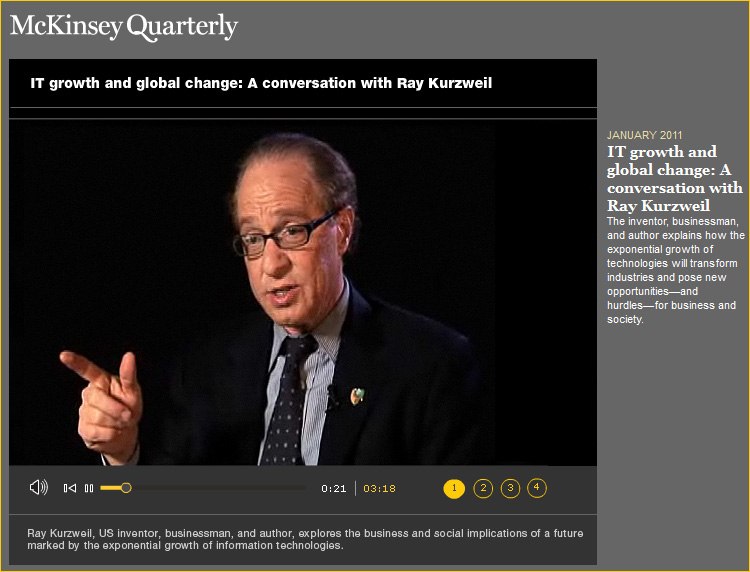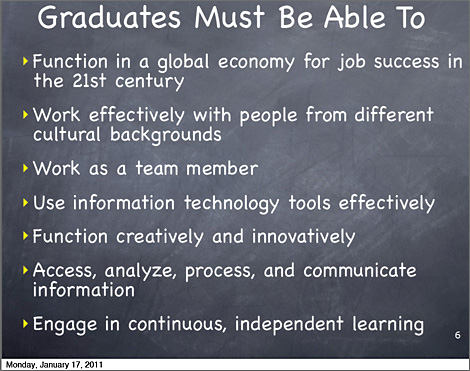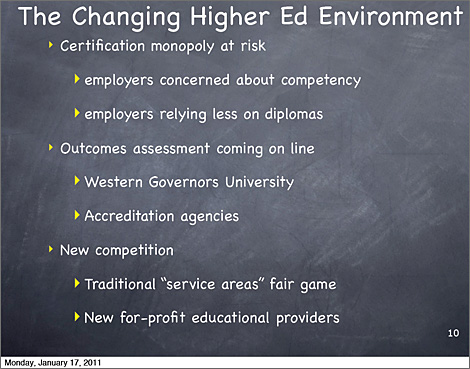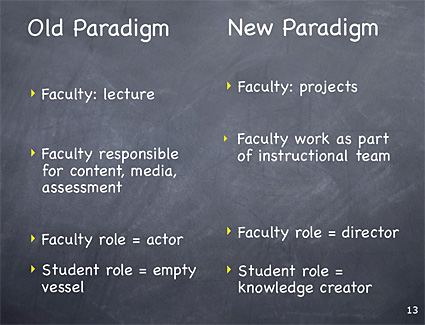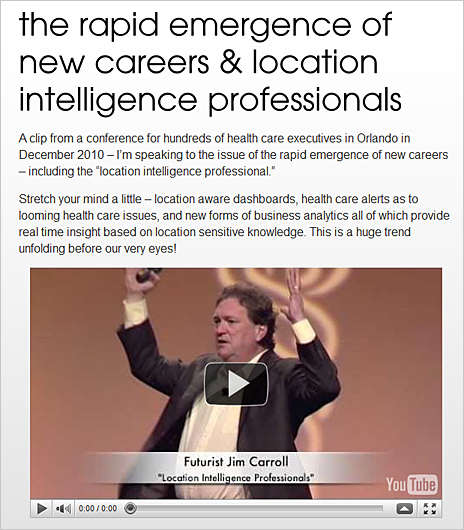Change is exponential…not linear.
Example slides/excerpts:
.
.
.
.
One example — of several great slides — regarding the old vs. the new paradigm:
.
.
.
From DSC:
Re: one of the bullet points on the last slide — i.e. “Faculty work as part of instructional team” — here’s my take on what that team increasingly needs to look like in order to engage our students and to compete:
.

Online Communities Spark Future Changes in the Training Profession (Interview) — from Bloomfire.com
Excerpts:
Q. Could you envision a 21st century training program for us? What might it look like?
This can be best described by what was said by John Chambers, CEO, Cisco Systems: “Education over the internet will make email look like a rounding error.” Chambers explains that education is not just evolving, but rather going through a complete transformation.
Q. How might these challenges differ from the challenges of yesterday?
Emerging communication methods, like instant communication and collaboration, have vastly changed the landscape of the way people assimilate information. Time has always been considered a scarce resource, but it has now become even scarcer than before. We need to adapt to the very rapidly changing environment as training shifts its focus to learning.
Q. In response to this shift, what are some research and technological trends today that will have an impact on tomorrow?
The high-definition video conferencing, mobile learning, and innovative developments centered around social learning and performance support have the potential to lay the foundation of anytime-anywhere learning, in real-time.
Survey points to radical makeover of traditional education — from free press release center
Online education is booming according to longtime online higher education pioneer, Dr. Fred DiUlus.
Excerpt:
January 23, 2011 (FPRC) — Online education is booming according to longtime online higher education pioneer, Dr. Fred DiUlus. As the founder and CEO of online university builder, Global Academy Online, he has witnessed first-hand the exponential growth of the online education industry. Traditional educators are just now beginning to seriously pull back the layers of opportunity that exist within the virtual world for today’s technologically savvy students.
Many traditionalists have complained over the years about what they perceive as the inadequacy of virtual education. They believe that somehow online education would destroy rigor and academic accomplishment if universities even dared to adopt online protocols in a major way. The father of modern management, the late Peter Drucker, predicted that schools as we know them will cease to exist in a generation replaced by their virtual counterparts.
Skeptics in higher education have long questioned Drucker’s ominous prediction. Global Academy Online’s own statistical research over the past eight years appears to bear out Drucker’s forecast contrary to what others in the field think and perhaps sooner than even Drucker expected. In 2002, the Academy began collecting statistical data from students attending traditional colleges and universities. The results of the eight-year survey are so startling that it now appears proof positive of the inevitability of Drucker’s prophecy.
.

From DSC:
Steve Taffee makes some good points in his blog posting entitled, “What if your cloud evaporates?”
When vendors offering cloud-based apps and services suddenly no longer support or offer a product line or they begin charging for what was previously free, etc. — this creates a significant issue. Quoting Steve’s posting:
The off-again, on-again fate of the social bookmarking service Delicious led to considerable angst among its users, with the discussion among some educational technologists broadening to include all cloud-based services and scenarios of suddenly being without access to mission critical services.
This is another reason why I entitled this blog Learning Ecosystems — because all of the people, tools, and things that can contribute to our learning are often in a constant state of flux/change. So we are forced to adapt. However, this is easier said than done when suddenly 10,000 students can’t access application ABC or service XYZ on the cloud. This is a truly problematic situation. It won’t stop cloud computing from moving forward, but it would sure be helpful if vendors would be required to give some sort of “heads-up” to help us address this issue and find alternatives well in advance of having to make a switch.
‘First iPhone app that lets you transfer money’ — from The Telegraph by Kara Gammell
First Direct has become the first UK bank to launch a true transactional banking app for Apple’s iPhone and iPod Touch.
“Predicting the future of the Internet is easy: anything it hasn’t yet dramatically transformed, it will.” — from Chris Dixon
The Internet has gone through fits and starts – in particular the dot com crash of 2000 disillusioned many – but every year we see it transform industries that previously sauntered along blissfully denying its existence (emphasis DSC). Already transformed: music, news, advertising, telecom. Being transformed: finance, commerce, TV & movies, real estate, politics & government. Soon to be transformed (among many others): healthcare, education, energy.
From DSC:
I used to think education was “on-deck” — but not anymore. It’s at bat.
Millennials replacing Baby Boomer workforce: Meeting their unique needs — from Diane Hamilton
Big changes are occurring in the current workforce. The dynamic is shifting as companies are experiencing a shift toward millennials replacing baby boomer generations. According to Harvard Business Review /HBR.org, “The makeup of the global workforce is undergoing a seismic shift: In four years Millennials—the people born between 1977 and 1997—will account for nearly half the employees in the world. In some companies, they already constitute a majority.” (emphasis DSC)
Blockbuster vs. iTunes/Netflix…now Barnes & Noble vs. Borders:
- See “Digital Divide Propels Barnes & Noble Past Rival” — from NPR by Lynn Neary
The digital divide has created a chasm between the nation’s two biggest bookstore chains: While Borders is trying to hold off bankruptcy, Barnes & Noble announced Thursday its best holiday sales season in more than a decade.
“Thrilled” was the word Barnes & Noble Chief Financial Officer Joseph Lombardi used to describe the mood at his company. Holiday sales at BarnesAndNoble.com were up 78 percent over last year; store sales increased by almost 10 percent. While sales of hardcover books were better than expected, Lombardi made it clear that Barnes & Noble’s popular e-readers, the Nook and the Nook Color, were behind the good news.









